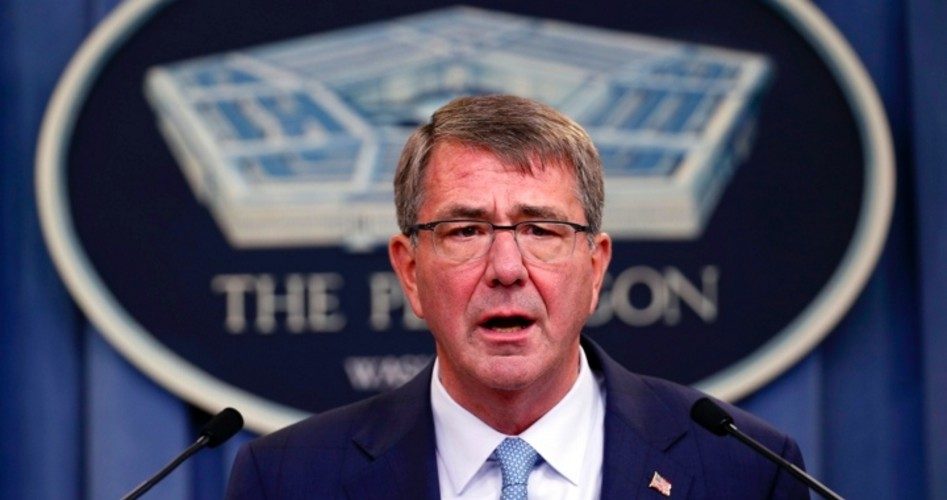
Speaking at a press briefing in the Pentagon Briefing Room on June 30, Secretary of Defense Ash Carter (shown) announced that the Defense Department is “ending the ban on transgender Americans in the United States military.”
Transgender people have been prevented from serving in the military under Pentagon and military medical regulations implemented more than 40 years ago barring people who have had a sex change operation and/or have “gender identity disorders” from military service. Unlike “don’t ask, don’t tell,” the former policy that prevented open service by lesbian, gay, and bisexual people, the transgender ban is a military regulation, not written into federal law. Therefore congressional action is not needed to lift it.
Carter continued with his announcement:
Effective immediately, transgender Americans may serve openly and they can no longer be discharged or otherwise separated from the military just for being transgender.
Additionally, I have directed that the gender identity of an otherwise qualified individual will not bar them from military service or from any accession program.
In his announcement, Carter provided what he considered to be justification for making a dramatic change that is bound to have a strong impact on the culture of our military branches.
The first reason he presented was: “We have to have access to 100 percent of America’s population for our all-volunteer force to be able to recruit from among them the most highly qualified and to retain them.”
Carter cited RAND Corporation estimates that about 2,500 people out of approximately 1.3 million active-duty service members, and about 1,500 out of 825,000 reserve service members are transgender, suggesting that to ban these individuals would represent a major loss to the military’s talent pool. Since that represents just .1875 percent (less than 2/10s of one percent) of all military personnel, continuing the ban on transgender personnel obviously would have a negligible effect on military strength.
The second reason given by Carter for changing current policy is to provide commanders with “better guidance on how to handle questions such as deployment, medical treatment and other matters.”
Expanding on this point, Carter said that “right now, most of our transgender service members must go outside the military medical system in order to obtain medical care … judged by doctors to be necessary, and they have to pay for it out of their own pockets.”
Since being transgender is not a medical condition with any physical manifestations (except for those that might be self-induced by the transgender person’s desire to bring his body into compliance with the gender with which he “identifies” — some seek medical treatments such as hormone replacement therapy or sex reassignment surgery), then it would be highly appropriate that the transgender individual should have to go outside the military medical system in order to obtain such arbitrary, elective medical care. It would also seem reasonable that they would have to pay for it out of their own pockets — except for one thing. And that is, an individual with such troubling self-identity issues is evidently suffering from a serious psychological disorder, which should bring his or her ability to serve in the military into serious question.
The third reason that Carter offered will undoubtedly cause Americans who espouse traditional Judeo-Christian moral standards and value our military’s centuries-old traditions and standards of military conduct, to roll their eyes in disbelief:
The third and final reason for the change, also important, is a matter of principle. Americans who want to serve and can meet our standards should be afforded the opportunity to compete to do so. After all, our all-volunteer force is built upon having the most qualified Americans, and the profession of arms is based on honor and trust.
This assertion is based on the premise that our military is some sort of civic club or athletic team that fairness requires all individuals be given an “opportunity” to join. The military’s sole criteria in developing its personnel standards should be building a force that will effectively serve to defend our nation. However, many military officers have argued that allowing homosexual (and, by extension, transgender) individuals hinders that mission.
Back when President Obama first sought to change the “don’t ask, don’t tell,” policy, in 2009, a Military Times survey showed that 58 percent of military respondents opposed a policy change, and 24 percent said they would either leave the military (10 percent) or consider terminating their careers after serving their tours of duty (14 percent).
Once Obama’s repeal of “don’t ask, don’t tell,” went into effect, an article in U.S. News & World Report in 2011 stated:
Half of the military’s youngest officers oppose gays serving in the military, with conservative male military academy cadets especially hostile to President Obama’s year-old repeal of Don’t Ask, Don’t Tell, according to a new survey from West Point scholars.
The article noted that during the debate over repealing “don’t ask, don’t tell,” service chiefs fought against the president’s plan, worried that it could undermine morale.
“Don’t ask, don’t tell” (DADT) was instituted by the Clinton administration on February 28, 1994. The policy prohibited military personnel from discriminating against “closeted” homosexuals, while at the same time barring openly gay, lesbian, or bisexual persons from military service. Engaging in homosexual activity had been grounds for discharge from the U.S. military since the War for Independence, so DADT actually represented a more hospitable environment for homosexuals willing to keep their activities private. The policy was introduced as a compromise measure in 1993 by President Bill Clinton, who had campaigned in 1992 on the promise to allow all citizens to serve in the military regardless of sexual orientation. After Clinton’s plan encountered strong opposition from the Joint Chiefs of Staff, members of Congress, and much of the public. DADT was offered as a compromise policy.
DADT was ended by the Obama administration in 2011. It was an indication of just how quickly the government’s liberalization of policies related to LGBT individuals has moved, that our military went from a total ban on homosexuals in the military to the removal of DADT and complete acceptance of such individuals in a matter of just 18 years. And now, just five years later, the Defense Department has just removed restrictions on transgendered (the T in LGBT) individuals, as well.
The new policy will be phased in over a one-year period, notes the DOD press statement. Effective immediately, service members may no longer be involuntarily separated, discharged, or denied reenlistment solely on the basis of gender identity. Transgender service members currently on duty will be able to serve openly.
In addition to changing policy in the active military, notes the statement, “an otherwise-qualified individual’s gender identity will not be considered a bar to admission to a military service academy, or participation in the Reserve Officers’ Training Corps or any other accession program if the individual meets the new criteria.”
Which means we will soon see transgendered people at West Point, Annapolis, and the Air Force and Coast Guard Academies.
One wonders exactly how transgendered individuals will express themselves while in uniform, now that female soldiers wear combat fatigues and boots indistinguishable from those male solders wear.
When we first read this report, before the bizarre reality of it had sunk in, we recalled the character Corporal Maxwell Q. Klinger, from the long-running M*A*S*H television series. Klinger was heterosexual (like many transgendered people also claim to be) but continuously attempted to gain a Section 8 psychiatric discharge from the Army by wearing women’s clothing.
While M*A*S*H was intended to be a comedy and Klinger was a fictional character, today’s announcement by Carter will produce an environment in our military that is neither fictional nor funny — but all too real.
Photo of Secretary of Defense Ash Carter: AP Images
Related articles:
Rape Victim: Transgender Agenda Creates “Rape Culture”
University of Arizona to Launch Nation’s First Transgender Studies Program
Kansas Board of Education Votes to Ignore Obama’s Transgender Directive
Sex Vs. Gender. Yes, There Is a Difference!
Robert Gates, Who Helped Dismantle DADT, Elected to Lead Boy Scouts
Pentagon to Extend Benefits to Same-Sex Partners of Military Personnel
Battle Brewing Over Conscience Protections for Military Chaplains
Military Writes Rules for Repeal of DADT Process
Oregon Judge Rules Transgenders May Change Sex to “Non-Binary.” What’s Next?
Running Into Insanity: “Trans” Boy Sprinter Takes Honors Competing Against Girls
Missing the Point on the “Transgender” Bathroom Wars
NYC Spends $265K of Taxpayer Money to Promote Transgender Bathroom Policy
Transgender Transformation: Hope and Change, One Locker Room at a Time?
Ga. ACLU Director Resigns Over Transgender Bathroom Issue
Trans-thinking: When 98 Percent of Students Would Let Men in Women’s Sports
Boys Showering With Girls — What Next?
D.C. Security Guard Charged With “Hate Crime” for Removing Man From Women’s Restroom
Latest Battle Over LGBT Ordinances Hits Phoenix
North Carolina, Texas Reject Obama’s “Transgender” Directive
Obama Ed: Transgenders May Use Locker Rooms of Opposite Sex
North Carolina’s Bathroom Battle Over States’ Rights
Obama’s Transgender Agenda Pushes Into Schools
DOJ Claims N.C. Transgender Bill Violates Civil Rights Laws
U.S. Foreign Policy: Spread Homosexual Agenda
Transgender Restrooms: Not a Federal Case
Obama AG Loretta Lynch: Don’t Call Them Young Criminals — They’re “Justice-involved Youth”
Target’s Bathroom Policy: Politically Correct, But Dead Wrong
Oral Roberts University Case Another Threat to Religious Schools
ESPN Fires Analyst for Opposing Men in Women’s Bathrooms
Federal Appeals Court Rules Va. School’s Transgender Bathroom Policy Discriminatory


